
Understanding the Used Farm Equipment Market: Lessons from the Bradley Tractor
The used farm equipment market is a dynamic landscape where shrewd investment can yield substantial returns, but poor decisions can lead to costly mistakes. For more on tractor reliability, see this helpful resource on Mahindra tractor reliability. This analysis uses the story of the Bradley tractor—a compelling case study of a technically sound machine that struggled to gain market traction—to illustrate the complexities of this market and provide actionable insights for buyers and sellers alike. Launched in the 1930s, the Bradley tractor boasted impressive power and performance. However, factors such as high pricing, limited accessories, and potentially inadequate marketing contributed to its relative failure. This underscores the fact that success in this industry relies on more than just technical excellence.
The Bradley Tractor's Story: More Than Just Horsepower
The Bradley tractor's tale serves as a potent reminder; in the used heavy equipment market, horsepower is only one piece of the puzzle. Market demand fluctuates significantly, mirroring trends in construction and agriculture. A tractor's longevity directly impacts its resale value—a durable machine retains its worth far better. The availability of replacement parts is paramount; scarce parts drastically reduce a tractor's appeal and value. Technological advancements also play a crucial role. Features once considered cutting-edge, such as automatic hydraulic lifts and power take-offs (PTOs) (the systems that power implements attached to the tractor), are now commonplace, impacting the desirability of older models.
Evaluating a Used Bradley Tractor: A Practical Guide
Considering the purchase of a used Bradley tractor? Here's a systematic approach to ensure a sound investment:
Condition Assessment: A comprehensive inspection is non-negotiable. Thoroughly examine the engine, listening for any irregularities. Test the transmission rigorously and scrutinize the entire structure for wear and tear. A pre-purchase inspection by a qualified mechanic is strongly recommended.
Parts Availability: Determine the accessibility of replacement parts. If parts are difficult or impossible to source, the tractor’s long-term viability is compromised.
Maintenance History: A well-maintained tractor is less likely to require expensive repairs. Request complete service records and meticulously review them. A consistent maintenance schedule is a strong positive indicator.
Price Comparison: Research the market value of comparable used tractors. Ensure the asking price aligns with the tractor’s condition and market trends.
Needs Alignment: Does the Bradley tractor’s capabilities align with your specific operational requirements? Selecting a tractor suitable for your needs is paramount.
Navigating the Shifting Sands: Future Trends in Used Farm Equipment
Several factors will significantly shape the used farm equipment market in the coming years:
Technological Advancements: Manufacturers continuously strive to enhance efficiency and sustainability, incorporating features like improved fuel economy and reduced emissions.
Government Regulations: Emissions standards and safety regulations directly influence the demand for specific types of equipment. Compliance is crucial.
Sustainability Focus: The growing emphasis on sustainable agriculture drives demand for equipment that minimizes environmental impact.
Adapting to these trends is essential for success in this ever-evolving market.
Stakeholder Strategies: A Comparative Overview
Different stakeholders employ distinct strategies to thrive in this market:
| Stakeholder | Short-Term Strategy | Long-Term Strategy |
|---|---|---|
| Equipment Dealers | Prioritize exceptional customer service; offer flexible financing. | Invest in older tractor refurbishment and robust parts inventory. |
| Manufacturers | Focus on producing tractors that meet evolving farmer needs. | Develop innovative, environmentally friendly tractor designs. |
| Farmers/Contractors | Prioritize reliability and overall cost-effectiveness. | Consider extended service contracts for used equipment. |
| Government Regulators | Enforce safety and environmental regulations strictly. | Support infrastructure that accommodates used equipment utilization. |
Mitigating Risks in the Used Equipment Market: A Proactive Approach
The used equipment market inevitably presents risks. Proactive mitigation is key:
| Risk Factor | Risk Level | Mitigation Strategies |
|---|---|---|
| Equipment Obsolescence | High | Diversify equipment inventory; focus on models with upgrade potential. |
| Parts Acquisition Issues | Medium | Cultivate strong relationships with parts suppliers; refurbish parts. |
| Market Volatility | Medium | Diversify customer base; employ flexible pricing strategies. |
| Regulatory Compliance | Medium | Ensure full regulatory compliance; invest in cleaner technologies. |
Key Takeaways:
- The used farm equipment market offers significant opportunities but demands careful consideration.
- The Bradley tractor's story highlights the importance of factors beyond technical specifications.
- A thorough due diligence process is crucial when purchasing used equipment.
- Adapting to evolving market trends is essential for long-term success.
The used heavy equipment market, exemplified by the complex story of the Bradley tractor, showcases the intricate interplay between engineering prowess, market dynamics, and adaptability. Success hinges not only on the power of the engine, but also on a comprehensive understanding of the market and a robust, responsive strategy.